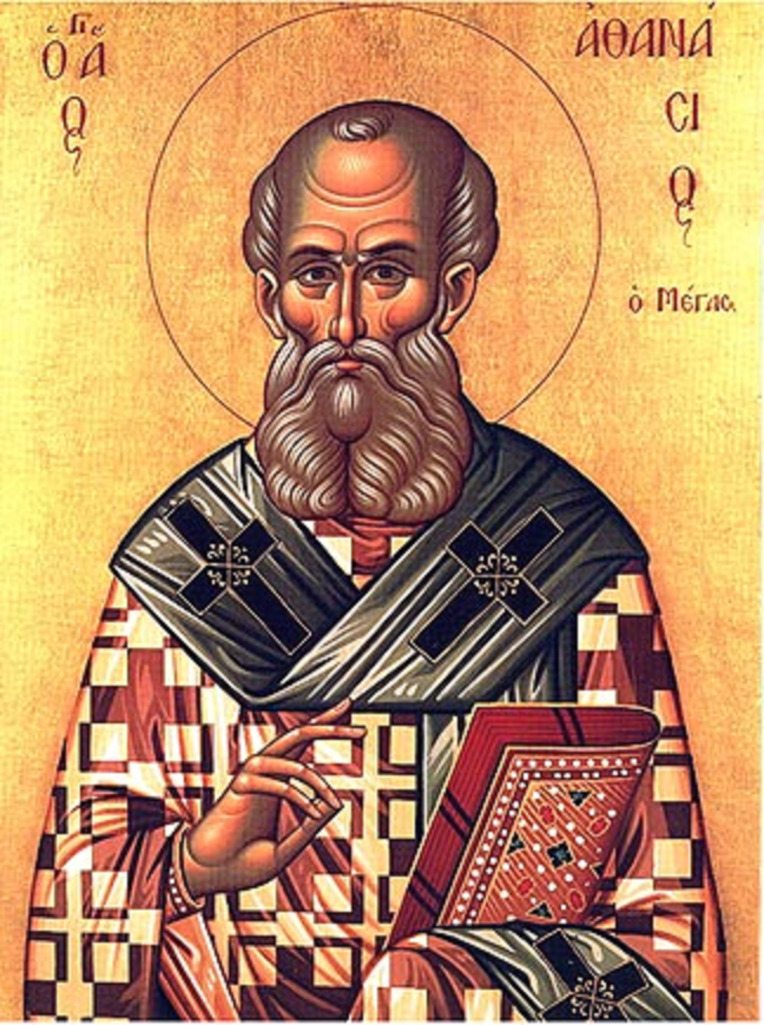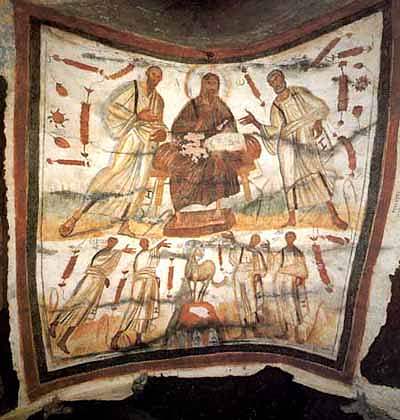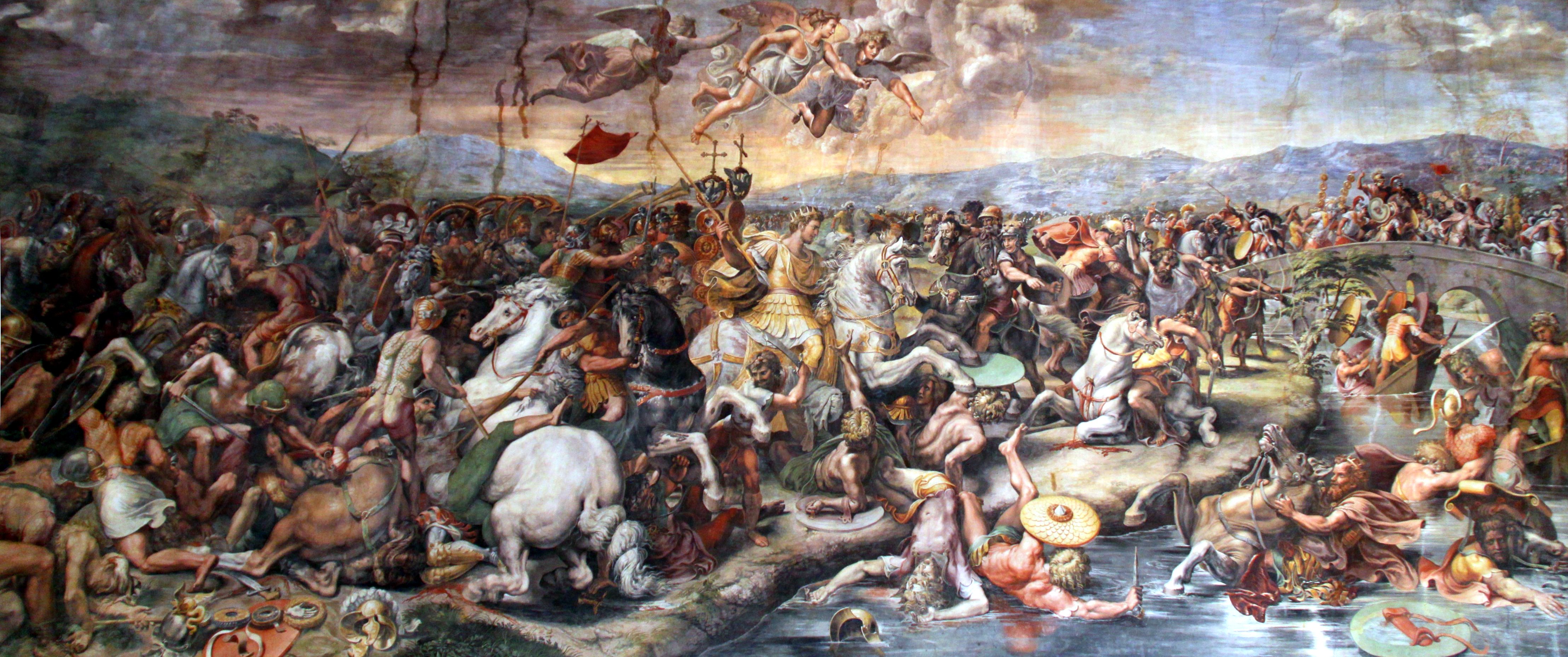The Coming of Christendom Appendix: The Arian Controversy
 |
| 9th Century Image of the Council of Constantinople |
Intro | Part I | Part II | Part III | Part IV | Part V a | Part V b |Appendix
Readers of the previous post in this series may have been surprised when they noticed a sizable gap in the history of the third and fourth centuries. While there important political developments that occurred after Constantine’s rise to power in the early 300’s, some famous theological achievements also occurred to. Punctuated at either end of the century by the first and second ecumenical councils, the fourth century had been described as the achievement of orthodoxy. Indeed you are more than likely familiar with the narrative; that in the year 318 “a wicked Alexandrian presbyter called Arius chose to propound a doctrine of relation of the Son to the Father which was completely unorthodox and heretical, and which was condemned by the first General Council of the church in Nicaea in 325, but that by various means the base and crafty supporters of this heretical doctrine managed to keep the orthodox out of influential positions and to continue to propagate their wicked ideas for another 60 years after Nicaea, until, almost wholly through the selfless efforts of a noble and courageous champion of orthodoxy, Athanasius bishop of Alexandria, the their politics were frustrated, their heterodoxy exposed, and the truth enshrined” in the creed of the Council of Constantinople in 381 (Richard Hanson, The Achievement of Orthodoxy in the fourth century AD).
The problem with this account of history is that it bears no resemblance to what happened. Orthodoxy had been passed down for the proceeding three hundred years through the rule of faith, the Roman baptismal creed (which has most likely come to us as the Apostles Creed), the scriptures – primarily the fourfold Gospels, and the gospel itself. But across those preceding centuries emerged different strands relating to the theology of the person of Jesus: North African theologian Tertullian developed an idea of the ‘economic trinity’; Alexandrian Origen talked of the eternal generation of the Son. Even the language used to describe the relation between the Father and the Son – ousia, hypostasis, substantia, persona etc. ¬ had different meaning depending on whether you spoke Greek or Latin. The Arian controversy was one that resulted in determination of orthodoxy, rather than one consisting solely in the defense of orthodoxy.
When Arius’ teachings in Alexandria were brought to attention in 318, he found many supporters, such as Eusebius of Caesarea and the powerful Eusebius of Nicomedia, who understand him standing in one of these “orthodox” traditions. Arius’ doctrine may have been motivated by a rivalry between him and his bishop, Alexander. But at the heart of Arius’ struggle was an attempt to grasp with the metaphysical and soteriological implications of the New Testament’s witness of a suffering God. Exploiting the Hellenic philosophical heritage of the ancient world, the Arian answer to this issue was to postulate the existence of two gods: one high impassable God, and a lesser God who suffered for him. According to the eminent historian of this period Richard Hanson:
“The Arians were among the few theologians of the early church who seriously understood the scandal of the cross. But the price which they thought it necessary to pay for this theology was too high.”
As a lower God, the logos was of a different essence and status to the Father. Using philosophical logic, the Arian position reasoned that the Son, as the first born over creation (Colossians 1:15) was an emanation of the Father. He was important, but in the words of one Arian song of the day "There once was a time when the Son was not".
Nicaea was intended to end several years of back and forth between Arius and his supporters and Alexander and his supporters. Arius was exiled, the doctrine of Alexander and his young deacon Athanasius upheld, and almost all present at the council signed the Creed under Constantine’s pressure for one unified church and empire. But the words of the Nicene Creed only added to the confusion. It taught the Son was ‘from the substance’ of the Father, ‘consubstantial’ with him, and condemning anyone who taught that the Son was ‘from another hypostasis or ousia’. But what these two words meant could be interpreted by different sides. The word homoousios (same substance) was also inserted into the Creed because it had been specifically rejected by Arius. But given it’s etymology in Gnosticism, it too was disputed by the Arian supporters who continued on the fight after Nicaea – the subordinates led by Eusebius of Nicomedia. In its place was proposed the word homoiousios (like substance).
The Nature of the Debate
 |
| Athanasius Patriarch of Alexandria |
Debate continued for the next several decades over the interpretation of the words in the Creed. Athanasius (296-373) succeeded Alexander as Bishop of Alexandria in 328. He is famously said to have stood alone against the world in his defense of the Nicene position. Athanasius was exile five times over the course of his episcopacy with the rise and fall of theological parties at the Imperial court in Constantinople (although he was also ostracised for a period of twenty years for his abuse of power and use of violence in suppressing his enemies in Egypt). It was a debate that was largely conducted in Greek philosophical categories. All sides appealed to the Scriptures, and biblical language was used by both sides. Both sides then were driven to using the only alternative vocabulary at their disposal: Stoicism, Middle Platonism and Neo-Platonism. There was none other available. But it was language that was used for theological purposes rather than for strictly philosophical ends.
It was a debate that was carried out in the political sphere as well. Each party attempted to bring Constantine and his successors on side.
“And inasmuch as the peace and stability of the Empire was to some extent bound up with the peace and stability of the church, it was virtually unavoidable that the Emperor should become involved. But because the secular power was involved, it does not follow that the controversy was simply a story of man grasping at secular power under the mask of theology” – Hanson.
The majority of the theologians of the fourth century were bishops. They all had pastoral responsibility, charged with the spiritual welfare of their flocks, the men and women who held them account. “They were conscious of a praying and worshiping church” (Hanson). And the words they used to describe orthodoxy come from the word eusebia, which besides meaning ‘true’ and ‘correct’ meant ‘devout’ and godly’. It is a mistake to consider the debate of the fourth century as either an abstracted intellectual exercise, or the political machinations of a few. At the heart Christianity stood both monotheism and the worship of Jesus Christ (rather than the cult of a deified man). This was the faith for which thousands of Christians had in the preceding years died for. The two convictions needed to be reconciled.
Neo-Nicene movement towards 381
The process of reconciliation began in 362. The new pagan Emperor attempted to cause disruption to the church by recalling all exiled bishops. Athanasius returned to Alexandria and used the opportunity to gather Christians from both the Nicene and Subordinate parties. The Council of Alexandria allowed the term homoiousios to be reconciled with homoousios. This provided for people of orthodox persuasion to use homoiousios legitimately when describing the co-equal relationship of the Son to the Father. This was affirmed again at a council in Antioch in 363, and in a letter to the eastern churches from Pope Damasus. This new found unity moved the debate away somewhat philosophical concerns and back to the language to salvation and revelation.
“God become man, so that man might become God” – Athanasius, On the Incarnation
 |
| Gregory of Nazianzus Patriarch of Constantinople |
The long term effect of all this was to re-establish the prominence of the term homoousios, and a dispelling of the ambiguity which had been inherent in the term at Nicaea. And so emerged a new ‘Neo-Nicene’ orthodoxy—a fuller and more robust version of the theology which had initially been outlined at Nicaea. This Neo-Nicene faith was embodied primarily in the Cappadocian Fathers (Basil of Caesarea, Gregory of Nyssa, and Gregory of Nazianzus). It was their doctrinal acumen, with the support of Emperor Theodosius that laid the ground work for 381 by shifting the emphasis and grounds of debate. They denied that neither the Son nor the Spirit are subordinate to the Father, but are share an equality that is unaffected by the order with the Trinity. By doing so, they able to argue forcibly for the full humanity and full divinity of Jesus Christ:
“The unassumed is the unredeemed” – Gregory of Nazianzus
The Council of Constantinople met from May-July 381. The most prominent feature of the Council of Constantinople was the adoption of a creedal statement, reaffirming and clarifying the Nicene position. Constantinople retained the inclusion of homoosiuos, and unequivocally stated the Jesus – and the Holy Spirit – is fully God: one ousia in three hypostases. This was the solution to questions that had long vexed the church. It gave rise to other problems, such as the incarnation, but it excluded the Arian formulation of a high God beyond suffering and a lower God who may experience pain. Athanasius and the Cappadocian Fathers excluded the use of the pre-incarnate logos as a philosophical device to explain how a transcendent being could come into contact with transience and human experience without compromising himself. Jesus is either wholly God or he is not God at all. This is still the confession of the church through the Nicene‐Constantinopolitan Creed today.
“Athanasius above all recognised that if we take the New Testaments seriously we must concluded that Christ is not a safeguard God the Father involving himself with human affairs, but a guarantee that he has done so” – Hanson .
APPENDIX: Comparision of the Creeds of Nicaea and Constantinople*
| The Nicene Creed (325) | The Nicene‐Constantinopolitan Creed (381) |
| We believe in one God, the Father, Almighty, Maker of all things visible and invisible; And in one Lord, Jesus Christ, the Son of God, begotten of the Father, only begotten, that is from the being of the Father, God from God, light from light, true God from true God, begotten not made, consubstantial with the Father, through whom all things came into being, things in heaven and things on earth, who because of us men and because of our salvation came down and became incarnate, becoming man, suffered and rose again on the third day, ascended to the heavens, will come to judge the living and the dead; And in the Holy Spirit. But as for those who say, ‘There was when He was not,’ and ‘Before being begotten He was not,’ and that He came into existence out of nothing, or who assert that the Son of God is of a different substance or being, or is subject to alteration or change—these the catholic and apostolic Church anathematises. |
We believe in one God, the Father Almighty, Maker of heaven and earth, of all things visible and invisible; And in one Lord, Jesus Christ, the only begotten Son of God, begotten of the Father before all ages, light from light, true God from true God, begotten not made, consubstantial with the Father, through whom all things came into being, who because of us men and because of our salvation came down from the heavens, and was incarnate from the Holy Spirit and the Virgin Mary and became man, and was crucified for us under Pontius Pilate, and suffered and was buried, and rose again on the third day, in accordance with the Scriptures, and ascended to the heaven, and sits at the right hand of the Father, and will come again with glory to judge the living and the dead, of whose kingdom there will be no end; And in the Holy Spirit, the Lord and life‐giver, who proceeds from the Father, who with the Father and the Son is together worshipped and together glorified, who spoke through the prophets; in one holy catholic and apostolic church. We confess one baptism for the remission of sins; we look forward to the resurrection of the dead and the life of the age to come. Amen. |
* Changes in the Nicene‐Constantinopolitan Creed italicized.
Further Reading:
Athanasius, On the Incarnation.
Basil of Caesarea, On the Holy Spirit.
Richard Hanson, The Achievement of Orthodoxy in the fourth century AD, The Making of Orthodoxy, ed. Rowan Williams, 1989.
Richard Hanson, The Search for the Christian Doctrine of God, 1988.
Rowan Williams, Arius: Heresy and Tradition, 2001.


















